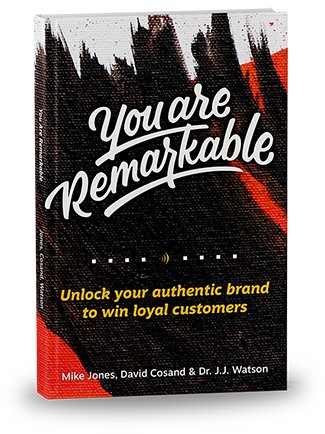Podcast: Play in new window | Download
Subscribe: RSS
If you’ve got a B2B brand – selling your products and services to other businesses – then you know that there are some very unique challenges to marketing your business-to-business brand. A lot of the branding lessons out there are great – and some certainly translate to B2B. But most of those lessons are built on business-to-consumer marketing. These lessons often fail to connect to the B2B world.
I’ve learned a few lessons for B2B brands working with business leaders building and growing remarkable B2B brands leading our creative branding agency. And I want to share some of these lessons today and hopefully help you grow your B2B brand.
Here are three unique challenges to marketing a B2B brand and some ways you can overcome them:
1.) B2B brands are built on human-to-human relationships first.
Unlike many B2C brands, the first meaningful interaction a potential customer has with a B2B brand is with a person. Many B2C brands can get all the way from the first ad or marketing message to the first purchase transaction without the customer ever interacting with a human representative of the brand.
Consider how you buy a new drink. You might see an ad on TV and then maybe some sponsored social posts about the product. Then while at the store (or online), you see the product and its packaging, get curious, and put it in your cart to purchase. Even if you deal with a cashier or salesperson, they don’t directly represent the manufacturer. In fact, they probably don’t have any specialized training from the manufacturer to tell you anything more than what’s on the packaging or the Amazon product page. (Having worked retail sales at a big-box electronics store in college, I can tell you the training I got on digital cameras definitely was less than half of the info you can find on a standard Amazon product page these days.)
Now let’s consider a B2B brand – perhaps a manufacturer of industrial machines. It’s highly likely you’re not seeing ads on TV, YouTube or social media for the product. It’s just too narrow a market of potential buyers. Instead, you might discover the brand through a tradeshow, conference, industry publication or direct marketing. You’ll likely have a conversation with a brand rep pretty early in the purchasing process. Perhaps even right there at the tradeshow. And you certainly are going to have even more conversations in the research and final sale phases.
B2B marketing requires tight integration between messaging and brand representatives.
B2B marketing requires a much tighter integration of messaging and the people who directly represent the brand. We’ll take a look at some of the reasons for that later in this article. But the core of those reasons is that B2B marketing involves more human interaction than in the B2C world. These human-to-human interactions happen much earlier in the marketing and sales process than B2C and are much more crucial to the customer experience prior to any kind of transaction.
The relationship with the customer becomes difficult to build if the messaging between ads, marketing collateral, platforms, and the people on the ground is off at all. Trust is threatened and it requires a lot of work for a sales or account rep to catch up. The brand and the people have to all be singing the same song. They should sing with their own personal voice and have the ability to flex to the specific needs of their customers. But all need to be singing the same familiar song.
This is why brand assets like taglines, a Brand Story, and visual guidelines are so, so critical. Without these (and some solid training of how to use and integrate them) representatives of the brand are left without a clear understanding of the story the customer has already been told in other marketing. I can’t tell you how many times I’ve heard from sales reps who are so frustrated with the marketing of their own brand because the story they’re telling customers is so different from what they’ve been told on the website, in an ad, or piece of collateral.
Getting everything AND everyone working together, singing the same song is so critical to building a remarkable B2B brand.
2.) B2B brands have to market to multiple decision-makers and decision-informers.
Yes, you can certainly find outlier B2C brands that also have this challenge – think automotive brands selling cars to married couples. But even then the complexity of decision-making in the marketing and sales process is nothing at all like B2B brands. Many of the B2B brands I work with have as many as 5-6 decision-makers to communicate with.
Consider an ERP software brand. Their customers are manufacturers and large service providers who need a system to tie all of their operations together and give them detailed reporting on nearly every aspect of the business so they can track and improve performance. This system is going to be used daily by production, HR, finance, sales, and even marketing. It’s highly likely that the CEO, COO, and CFO will have a big stake in the final decision to purchase this particular software product. Certainly, the CIO also has a big stake in the game (and will likely be responsible for rolling it out and maintaining it). But it’s unlikely any of these people will be the ones doing initial research on different ERP products, initial demos, or even specking out all the needs. There will be at least another small handful of people involved.
So who does this ERP software brand target with their marketing? The tough answer is probably: all of them. Of course, each of these people will enter into the decision-making process at different points, and not all have the final say. But all of them will play critical roles in either making or informing the final decision. And if just one key person isn’t on board with the decision, the sale could fall through.
The value of B2B buyer personas
For B2B brands, marketing to an entire account is tough. It requires a lot of research, strategy, and different messages and types of assets to key on the particular needs, pain points, and context of each person involved from the customer’s side. It’s certainly complex and requires a different approach than most B2C brands.
One of the most important tools for B2B brands in dealing with this complexity is clear and well-researched buyer personas for each of these decision-making roles in a prospective customer’s business. Identifying their unique contexts, pain points, and goals will deliver huge dividends when creating messaging and going to market. You’ll know how to speak to each of them in a way that resonates with their particular needs AND you’ll be able to identify the right assets to create to get their attention.
3.) B2B marketing and sales cycles are long.
Compared to a lot of B2C brands’ marketing and sales cycles, B2B brands’ can feel like an eternity. Weeks, months, and even years are the measuring scale for B2B brands as compared to days or even hours for some B2C brands.
There are a ton of factors that play into the length of marketing and sales cycles for any brand, but for some of the same reasons we’ve already mentioned (like the relationship-first approach and a high number of decision-makers) as well as others (like the budgets, length of the contract, and even complexity of contracts) most B2B brands experience long marketing and sales cycles.
Most B2B products and services just can’t be bought on a whim or negotiated in a single stop at an office. They require multiple people, product demos, various proposals, and contract negotiations, and likely some kind of legal review. And that’s not counting any of the marketing cycles prior to any kind of ‘sales process’.
I remember working with a product brand that was looking to get out of selling directly through retailers and instead sell bulk to distributors. They were transitioning from B2C marketing and sales processes into thinking more B2B. One of the more surprising discoveries: the relationship-building process with the big distributors could take YEARS.
Overcoming the challenge of long relationship-building cycles
While at a tradeshow they got to talking with one distributor rep about how they could get the attention of more distributors – especially the bigger ones in their industry. This rep’s answer: make sure you show up at this tradeshow at least 5 years in a row. Many distributors would watch brands year-over-year at the tradeshow to see if a brand would keep coming back, grow their booth size, and basically prove they were growing. Only after several years of seeing this would some of the big distributors even approach the brand to consider a deal. (And I thought our sales cycles were long for branding projects. Sheesh!)
So how do you overcome these long relationship-building cycles? Clear storytelling, from the get-go. Be clear about who you’re uniquely positioned to help. Know how your product or service solves their unique pains. And clearly demonstrate how it makes their lives better. Bonus points if you can do that with different kinds of media (articles, ads, ebooks, videos, podcasts) targeted at the different roles of decision-makers involved in the process. Best-case: focus on one or two roles that are the most critical to the sale. And it’s not always the CEO role. It could be the CFO or CIO. But there’s nearly always one or two that if you can really get them bought into your brand and your solution, through a good relationship, all the others will be infinitely easier.
Consistency and strong relationships are crucial for B2B marketing
As you can see (and probably already know) B2B marketing is vastly different from B2C. A lot of the surface level is similar, for sure. There are ads and content and websites and logos and messaging. But the nuances are what make all the difference. And if you treat them the same, you’ll find your marketing is that much harder and inefficient.
Get a kickstart for your B2B marketing planning with our FREE Relationship Marketing Worksheet. It will help you strategize your messaging, buyer personas, and campaigns.
And if you want to dig deeper on this topic and connect with some like-minded marketers and business leaders, sign up for our new Brand Roundtable Chats. These are limited-capacity, deep-dive sessions to dig into the brand-building issues and challenges in our various businesses. I’d love to see you at one soon!



